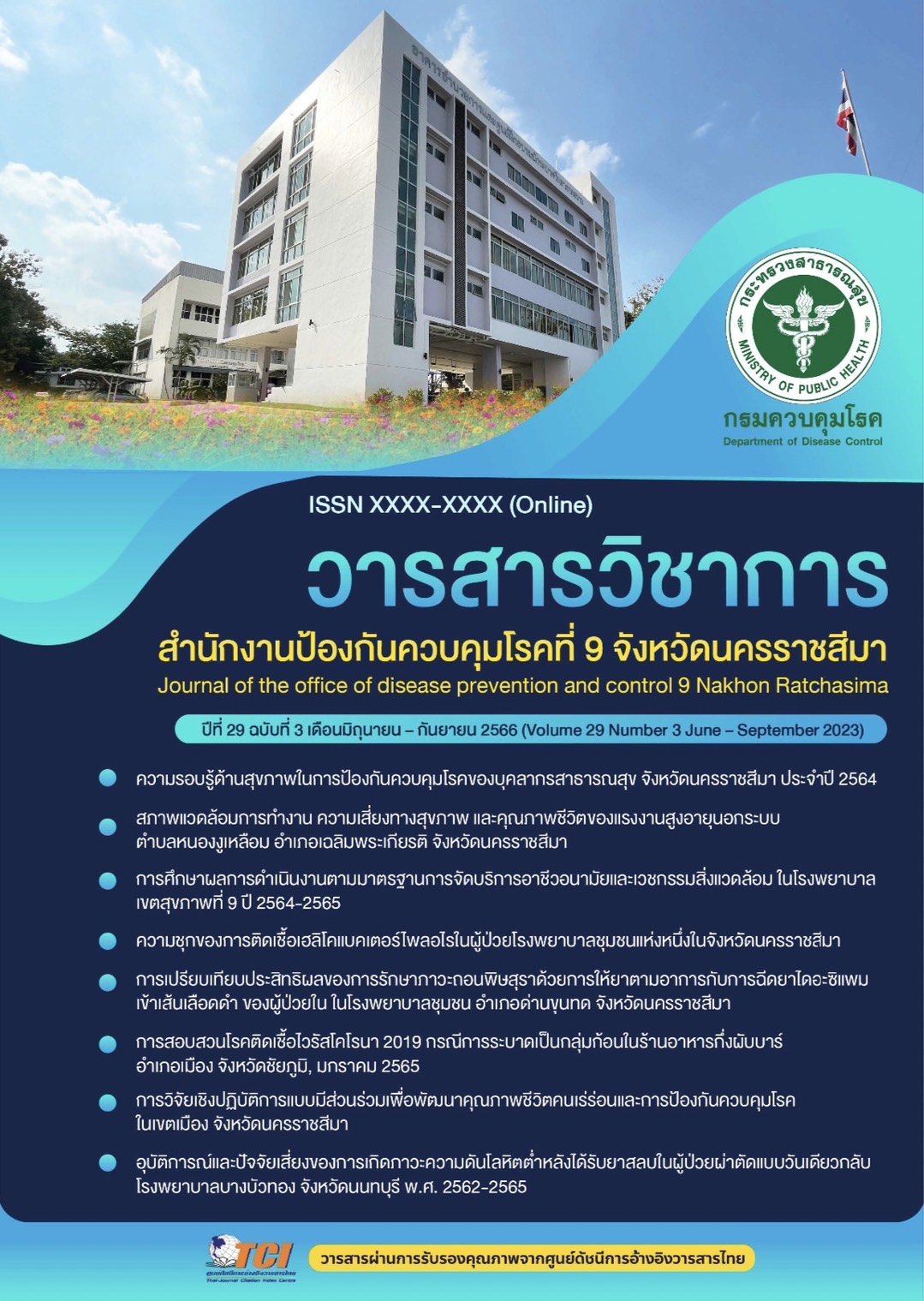Comparison of the Effectiveness between Symptom-Triggered Regimen and Intravenous Loading Diazepam Regimen for Alcohol Withdrawal In-Patients in a Community Hospital, Dan Khun Thot District, Nakhon Ratchasima Province
Keywords:
Alcohol withdrawal, Symptom – triggered regimen, Intravenous loading Diazepam regimenAbstract
Alcohol withdrawal with severe symptoms can lead to hospitalization. It also presents complications among patients with alcohol dependence while hospitalized with other diseases, such as delirium or psychosis. The regular treatment plan aims to promptly alleviate patients' symptoms without complications. Therefore, this retrospective observational study aimed to compare the effectiveness of treating severe alcohol withdrawal symptoms with Benzodiazepine between a symptom-triggered regimen and an intravenous loading Diazepam regimen among 136 patients with alcohol dependence (ICD 10: F1030/F1031). The AWS (Alcohol Withdrawal Scale) score 15 was used to diagnose in-patients admitted to the male ward at Dan Khun Thot Hospital, Nakhon Ratchasima Province, between October 1, 2017, and December 31, 2021. The participants were divided into two groups: the first group received the symptom-triggered regimen, while the second group received the intravenous loading Diazepam regimen. A total of 136 participants were diagnosed with alcohol withdrawal, with 66 participants receiving the symptom-triggered regimen (group 1) and 70 participants receiving the intravenous loading Diazepam regimen (group 2). The median length of time (hours) for participants with AWS score
15 in both groups was 40 and 28 hours, respectively (p=0.002). The mean AWS score during hospitalization was 13.5 ± 2.68 for group 1 and 12.5 ± 2.34 for group 2, respectively (p=0.029). The AWS scores for symptoms such as perspiration, anxiety, and agitation revealed that the AWS score of group 2 after receiving the treatment was significantly lower than that of group 1 (p < 0.05). Regarding complications, psychosis occurred only in group 1, affecting approximately 7.6% of patients (p=0.025), while sleep apnea did not emerge in either group. Moreover, the dose of Benzodiazepine used to treat the symptoms showed that the dose equivalent effect to Diazepam in group 1 and group 2 was 287.5 mg and 400 mg, respectively (p < 0.001). In conclusion, the treatment of alcohol withdrawal using the intravenous loading Diazepam regimen reduced the severity of alcohol withdrawal with severe symptoms more rapidly than the symptom-triggered regimen. Additionally, it decreased perspiration, anxiety, and agitation. Furthermore, there were no instances of sleep apnea as a treatment-related complication.
References
Elliott DY. Caring for hospitalized patients with alcohol withdrawal syndrome. Nurs Crit Care. 2019;14(5):18-30.
Bayard M, McIntyre J, Hill KR, Woodside JJr. Alcohol withdrawal syndrome. Am Fam Physician. 2004;69(6):1443-1450.
Foy A, Kay J, Taylor A. The course of alcohol withdrawal in a general hospital. QJM. 1997;90(4):253-261.
คณะอนุกรรมการพิจารณาด้านการบำบัดรักษาฟื้นฟูสภาพผู้ติดเครื่องดื่มแอลกอฮอล์. แนวปฏิบัติการคัดกรองและบำบัดรักษาฟื้นฟูสภาพผู้มีปัญหาการดื่มสุรา. พิมพ์ครั้งที่ 1 .กรุงเทพฯ:สำนักพิมพ์อักษรกราฟฟิคแอนด์ดีไซน์, 2561.
Sachdeva A, Choudhary M, Chandra M. Alcohol Withdrawal syndrome: benzodiazepines and beyond. J Clin Diagn Res. 2015;9(9):VE01-VE07.
The American Society of Addiction Medicine. Clinical practice guideline on alcohol withdrawal management. J Addict Med. 2020;14(3Suppl1):1-72.
Kattimani S, Bharadwaj B. Clinical management of alcohol withdrawal: a systematic review. Ind Psychiatry J. 2013;22(2):100-108.
Sen S, Grgurich P, Tulolo A, et al. A symptom-triggered benzodiazepine protocol utilizing SAS and CIWA-Ar scoring for the treatment of alcohol withdrawal syndrome in the critically ill. Ann Pharmacother. 2017;51(2):101-110.
Tantrakarnsakul K, Yoongthong W. Development of mechanism to solve the shortage of essential controlled medicines. Thai Food and Drug J. 2019;26(3):41-53.
Sangsirilak A. Comparison of oral and intravenous Diazepam for alcohol withdrawal treatment. Med J Srisaket Surin Burirum Hosp. 2020;35(3):643-650.
Daeppen JB, Gache P, Landry U, et al. Symptom-triggered vs fixed-schedule doses of benzodiazepine for alcohol withdrawal: a randomized treatment trial. Arch Intern Med. 2002;162(10):1117-1121.
Gold JA, Rimal B, Nolan A, Nelson LS. A strategy of escalating doses of benzodiazepines and phenobarbital administration reduces the need for mechanical ventilation in delirium tremens. Crit Care Med. 2007;35(3):724-730.
Wasilewski D, Matsumoto H, Kur E, et al. Assessment of Diazepam loading dose therapy of delirium tremens. Alcohol Alcohol. 1996;31(3):273-278.
Levine AR, Thanikonda V, Mueller J, Naut ER. Front-loaded Diazepam versus Lorazepam for treatment of alcohol withdrawal agitated delirium. Am J Emerg Med. 2021;44(Jun):415-418.
Obiora E, Hubbard R, Sanders RD, Myles PR. The impact of benzodiazepines on occurrence of pneumonia and mortality from pneumonia: a nested case-control and survival analysis in a population-based cohort. Thorax. 2013;68(2):163-170.
Cheng SY, Chen WY, Liu HC, et al. Benzodiazepines and risk of pneumonia in schizophrenia: a nationwide case-control study. Psychopharmacology (Berl). 2018;235(11):3329-3338.

Downloads
Published
How to Cite
Issue
Section
License
Copyright (c) 2023 The office of disease prevention and control 9th Nakhon Ratchasima

This work is licensed under a Creative Commons Attribution-NonCommercial-NoDerivatives 4.0 International License.
บทความที่ลงพิมพ์ในวารสารวิชาการสำนักงานป้องกันควบคุมโรคที่ 9 จังหวัดนครราชสีมา ถือว่าเป็น
ลิขสิทธิ์ สำนักงานป้องกันควบคุมโรคที่ 9 จังหวัดนครราชสีมา



